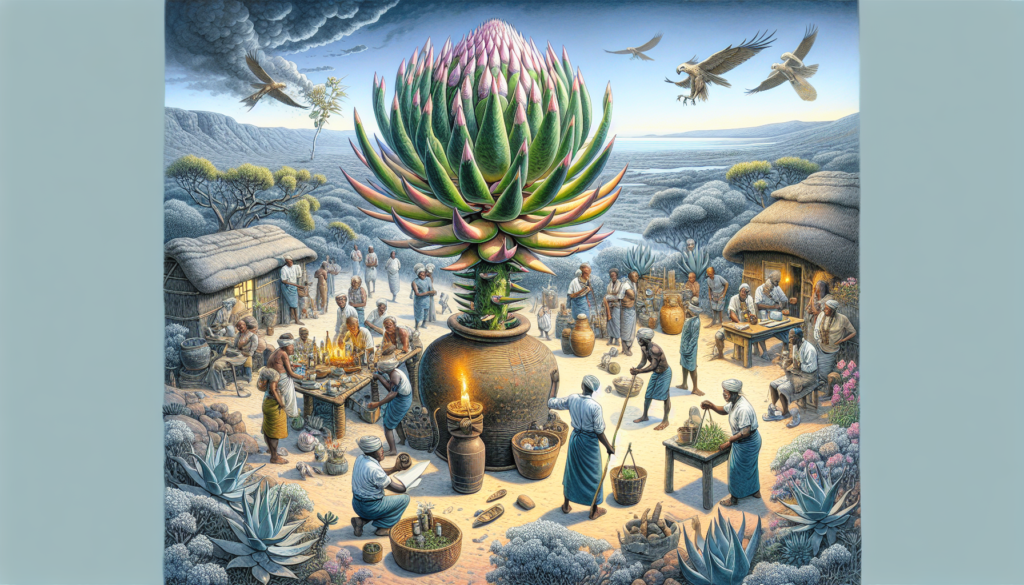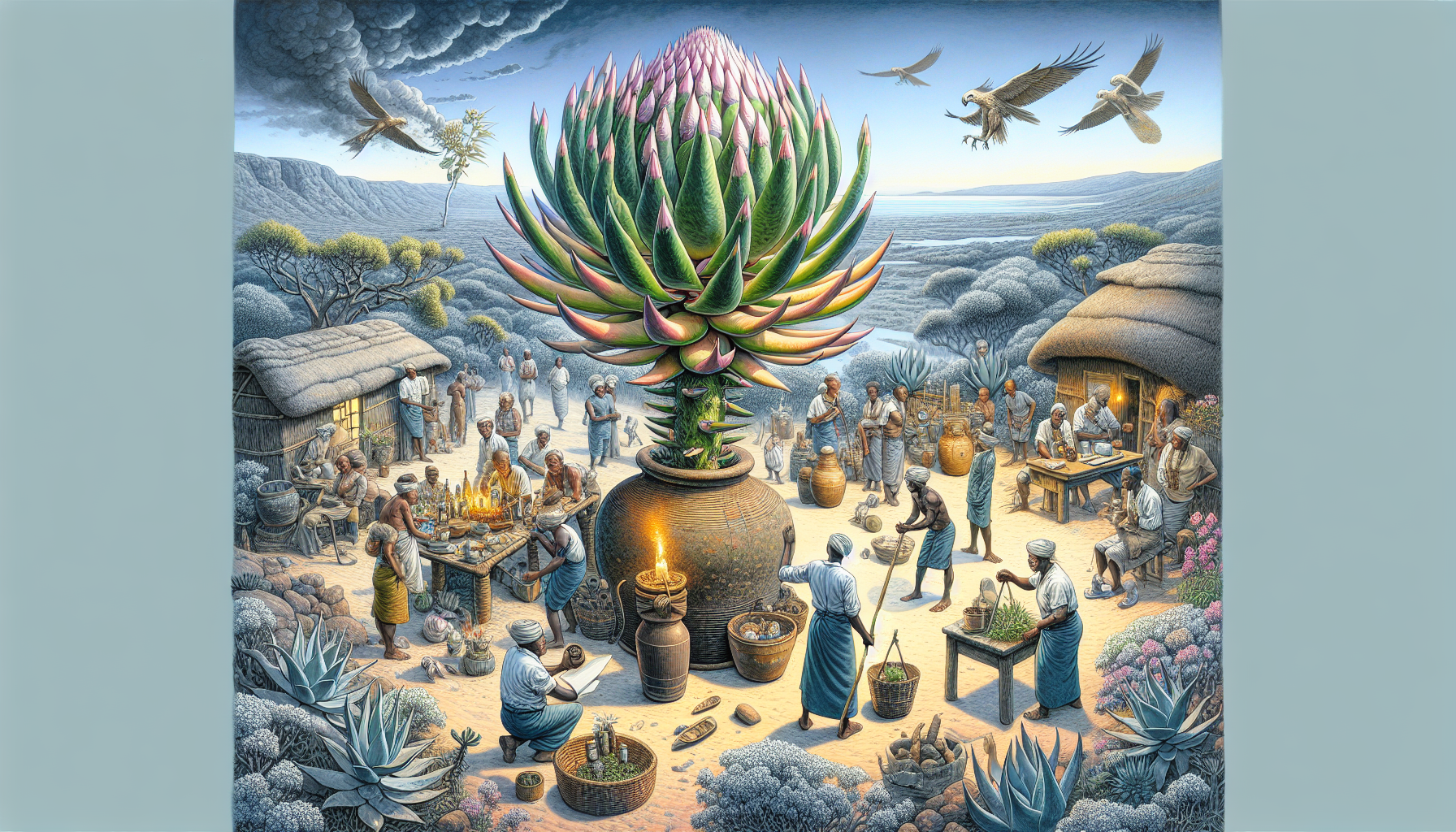Have you ever wondered about the ancient uses of Kanna? This powerful herb, also known as Sceletium tortuosum, has a rich history rooted in South African traditions. Throughout the ages, Kanna has been revered for its mood-enhancing properties and has been used by indigenous communities as a natural remedy for anxiety and stress. Join us on a journey as we explore the traditional use of Kanna and delve into its fascinating benefits for the mind and body.
History and Origins of Kanna
Origins of Kanna
Kanna, scientifically known as Sceletium tortuosum, originates from Southern Africa. The plant has a rich history, with indigenous tribes of the region using it for various purposes for centuries. The Khoi-San people, specifically the San and Khoikhoi tribes, hold a deep cultural connection to Kanna and have utilized its properties for generations.
Early Usage of Kanna
The early usage of Kanna predominantly revolved around its medicinal and spiritual qualities. The San people, in particular, valued the plant for its ability to alleviate hunger, thirst, and fatigue during hunts and long journeys. They would chew on the fresh leaves or stems of Kanna to naturally suppress their appetite and boost their endurance.
Furthermore, Kanna played an essential role in the rituals and ceremonies of the San people. It was believed to facilitate communication with ancestors and spiritual beings, fostering a deeper connection to the spiritual realm. Kanna’s psychoactive properties were utilized during trance dances and healing rituals, allowing individuals to transcend ordinary states of consciousness.
Cultural Significance of Kanna
Traditional Medicinal Uses
Kanna has long been employed in traditional medicine for various ailments. The plant’s alkaloids, such as mesembrine and mesembrenone, are believed to be responsible for its therapeutic effects. When prepared in specific ways, Kanna exhibits anxiolytic, mood-enhancing, and analgesic properties.
Indigenous communities have traditionally used Kanna to alleviate symptoms of depression, anxiety, and stress. The plant is believed to enhance mood and promote relaxation, providing relief from the burdens of daily life. Additionally, it has been used to ease physical pain, providing a natural alternative to conventional pain management methods.
Spiritual and Ritualistic Practices
Kanna holds immense spiritual significance in the cultures that have embraced it. Indigenous communities believe that the plant acts as a conduit between the physical and spiritual realms. During spiritual ceremonies, Kanna is consumed to induce altered states of consciousness, allowing individuals to connect with ancestors, spirits, and the divine.
Ritualists and healers value the plant’s ability to enhance intuition, insight, and empathy, facilitating guidance and healing. Kanna’s psychoactive properties are believed to aid in the journey of self-discovery and personal transformation, providing individuals with a deeper understanding of their purpose and place in the world.

Traditional Preparation Methods
Harvesting and Drying Kanna
Harvesting Kanna requires careful attention to ensure optimal potency and quality. The aerial parts of the plant, including the leaves, stems, and flowers, are typically harvested. Indigenous communities practiced sustainable harvesting, only collecting a portion of the plant to allow for regrowth.
After harvesting, the Kanna plant is dried in a well-ventilated area away from direct sunlight. Traditional methods involve spreading the plant material on racks or mats, allowing it to naturally air dry. The drying process can take several days, with regular monitoring to ensure the Kanna retains its potency.
Traditional Ways of Ingestion
The traditional methods of ingesting Kanna vary among different cultures and individuals. Chewing the fresh leaves or stems of the plant is one common approach, allowing for the direct absorption of the plant’s alkaloids into the bloodstream. This method offers a gradual onset of effects and is often used during long rituals or ceremonies.
Another popular method involves fermenting Kanna by placing the plant material in a container for a specific period. This fermentation process enhances the alkaloid content and potency of Kanna. After fermentation, the plant can be chewed, smoked, or used to prepare teas or tinctures for consumption.
Potential Benefits of Kanna
Mood Enhancement and Stress Relief
Kanna’s ability to enhance mood and alleviate stress has made it a popular choice for individuals seeking natural mood enhancers and stress relievers. The plant’s alkaloids interact with receptors in the brain, promoting the release of feel-good neurotransmitters like serotonin and dopamine.
By boosting serotonin levels, Kanna may help regulate mood, promote feelings of happiness and well-being, and reduce symptoms of depression. Additionally, its anxiolytic properties may provide relief from stress and anxiety, allowing individuals to experience a greater sense of calm and relaxation.
Anxiety and Depression Management
Kanna’s potential benefits extend to individuals dealing with anxiety and depression. Research suggests that the plant’s alkaloids may interact with receptors involved in the regulation of anxiety and mood disorders. Kanna’s anxiolytic and antidepressant properties may help alleviate symptoms associated with these conditions.
Furthermore, Kanna’s ability to increase the production of brain-derived neurotrophic factor (BDNF) may have neuroprotective effects and contribute to the growth and regeneration of neurons. This could potentially improve the symptoms of depression and anxiety by promoting greater neural connectivity and functionality.
Appetite Suppression and Weight Loss
For centuries, Kanna has been used by indigenous tribes as an appetite suppressant during times of food scarcity. The plant’s ability to reduce hunger pangs and cravings has attracted attention in modern times for its potential use in weight loss regimens.
Although more research is needed, preliminary studies suggest that Kanna may help individuals manage their appetite and promote weight loss. By stimulating certain receptors involved in appetite control, the plant may reduce food intake and contribute to a caloric deficit, thereby aiding in weight management efforts.
Cognitive Enhancement
Kanna’s cognitive-enhancing properties have been valued by indigenous communities for centuries. It is believed to boost mental clarity, focus, and memory, thus enhancing cognitive performance.
The alkaloids present in Kanna may have a positive impact on neurotransmitter systems, improving cognitive function. By modulating the release, reuptake, and binding of neurotransmitters such as serotonin, dopamine, and norepinephrine, Kanna may promote sharper cognitive abilities and increased mental acuity.
Pain Relief
Indigenous tribes have utilized Kanna as a natural analgesic for centuries. The plant’s alkaloids interact with receptors involved in pain perception, potentially reducing the sensation of pain.
Research suggests that Kanna may have analgesic effects comparable to nonsteroidal anti-inflammatory drugs (NSAIDs) in the management of mild to moderate pain. Whether it is used externally as a poultice or internally as a herbal remedy, Kanna shows promising potential as a natural pain reliever.
Alcohol and Drug Addiction Treatment
Kanna’s properties extend to the realm of addiction treatment, as some studies have shown its potential in reducing cravings and withdrawal symptoms associated with alcohol and drug addiction.
The plant’s alkaloids may interact with brain receptors involved in addiction pathways, helping to stabilize neurotransmitter levels and mitigate the urge to consume substances. However, further research is needed to fully understand and utilize Kanna’s potential in addiction treatment.

Safety and Precautions
Possible Side Effects
While Kanna is generally regarded as safe when used responsibly, there are some potential side effects worth considering. These can include mild gastrointestinal discomfort, headaches, dizziness, and changes in appetite.
Excessive consumption or misuse of Kanna could lead to more pronounced adverse effects such as increased heart rate, elevated blood pressure, and anxiety. It is important to start with a low dosage and gradually increase as needed, paying close attention to how your body reacts to the plant.
Interactions with Medications
As with any natural supplement or herbal remedy, it is important to be aware of potential interactions with medications. Kanna may interact with certain medications, such as antidepressants, sedatives, or medications that affect blood pressure, potentially enhancing or diminishing their effects.
To ensure your safety, it is essential to consult with a healthcare professional before incorporating Kanna into your routine, especially if you are currently taking any medications or have pre-existing medical conditions.
Pregnancy and Breastfeeding
Due to limited research and potential risks, it is not recommended for pregnant or breastfeeding individuals to use Kanna. The safety of the plant during these stages has not been thoroughly studied, and it is crucial to prioritize the well-being of both the parent and the child.
Dosage Guidelines
When using Kanna, it is important to follow dosage guidelines and start with a lower dose to assess your body’s reaction. The optimal dosage varies depending on the individual, their tolerance, and desired effects. It is advisable to start with 50-100mg and gradually increase if necessary, but never exceed the recommended dosage.
Exploring Modern Uses of Kanna
Research on Pharmacological Properties
Scientific research on Kanna’s pharmacological properties is ongoing, with studies aiming to uncover its full potential and mechanism of action. Researchers are exploring the plant’s impact on serotonin and dopamine receptors, as well as its potential as a natural antidepressant and anxiolytic.
Furthermore, investigations into Kanna’s possible neuroprotective effects, cognition-enhancing properties, and pain-relieving capabilities continue to shed light on the plant’s potential therapeutic applications.
Supplement Industry and Commercial Products
Kanna has gained popularity and recognition in the supplement industry, leading to the production of various commercial products. These include extracts, capsules, tinctures, and powdered forms of Kanna, making it more accessible to a wider audience.
When choosing commercial products, it is important to opt for reputable brands that prioritize quality control and source their Kanna sustainably. Reading product labels and customer reviews can provide valuable insights into the potency and effectiveness of different Kanna-based products.
Recreational and Social Uses
Kanna’s mood-enhancing and euphoric properties have led to its recreational use in certain circles. Some individuals use Kanna as an alternative to alcohol or other recreational substances, seeking a natural and potentially safer way to relax and socialize.
However, it is essential to approach recreational Kanna use responsibly and in moderation. Understanding its potential effects, dosage guidelines, and individual sensitivities is crucial to ensuring a safe and enjoyable experience.

Legal Status and Regulations
International Regulations
The legal status of Kanna varies across different countries and regions. In some areas, Kanna is considered a controlled substance, while in others, it is legal to possess, cultivate, or sell. It is crucial to be familiar with the specific laws and regulations regarding Kanna in your country or jurisdiction.
Local Legal Considerations
Even within countries with more lenient regulations, there may be specific local laws and restrictions regarding Kanna. It is important to research and adhere to these regulations to avoid any legal repercussions.
Before purchasing or using Kanna, it is advisable to consult local authorities or legal professionals to ensure compliance with local laws and regulations.
Sustainability and Conservation Efforts
Ecological Importance of Kanna
Kanna plays a vital ecological role in its native habitats. It is an indigenous species, adapted to specific environmental conditions, and supports local ecosystems. Kanna’s presence can contribute to biodiversity and the overall health of the ecosystems it inhabits.
Sustainable cultivation and preservation of wild Kanna populations are crucial to maintaining the ecological balance in these regions, as well as preserving the plant for future generations.
Ethical Harvesting Practices
Responsible and ethical harvesting practices are necessary to ensure the long-term sustainability of Kanna. Indigenous communities have practiced sustainable harvesting for centuries, utilizing only a portion of the plant and allowing for regeneration.
It is important for individuals and commercial entities to follow ethical sourcing practices, supporting fair trade initiatives and working directly with local communities to preserve traditional knowledge and protect Kanna habitats.

Gaps in Knowledge and Future Research
Limited Scientific Studies
While Kanna has a rich history and is well-regarded in traditional medicine, there is still a lack of comprehensive scientific studies on its potential benefits and mechanisms of action. Further research is needed to understand the plant’s bioactive compounds, optimal dosage, and potential interactions with medications.
Moreover, studies focusing on the long-term effects and safety of Kanna, especially in diverse populations, would contribute to a more thorough understanding of the plant’s properties and potential applications.
Potential Applications in Traditional Medicine
Beyond its traditional uses, there is potential for Kanna to play a role in modern traditional medicine systems. Integrating Kanna into traditional medicine practices could offer an alternative approach to managing various conditions such as anxiety, depression, and pain.
By combining traditional wisdom with scientific advancements, there is an opportunity to expand the utilization of Kanna and further explore its potential applications.
Conclusion
Preserving Traditional Knowledge and Cultural Heritage
Kanna holds immense cultural and historical significance for indigenous tribes, particularly the Khoi-San people. Preserving and honoring their traditional knowledge surrounding the plant is essential to maintaining their cultural heritage.
Promoting Responsible Use of Kanna
While Kanna offers potential benefits and has gained popularity, it is crucial to promote responsible use. Respecting dosage guidelines, understanding individual sensitivities, and prioritizing safety will contribute to a positive and informed approach towards utilizing Kanna’s properties.
Understanding the history, cultural significance, traditional uses, preparation methods, and potential benefits of Kanna allows for a comprehensive appreciation of this remarkable plant. By embracing its offerings responsibly, we can continue to explore its potential, support sustainability and conservation efforts, and promote the well-being of individuals and communities.



